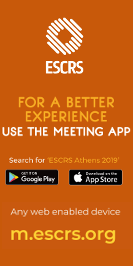Posters
(results will display both Free Papers & Poster)
Prevalence of pseudoexfoliation syndrome and it’s association with cataract and glaucoma in Kaunas, Lithuania
Poster Details
First Author: U.Rumelaitiene LITHUANIA
Co Author(s): D. ホali?nien? M. ハpe?kauskas
Abstract Details
Purpose:
To investigate the prevalence of pseudoexfoliation syndrome (PEX) and it’s association with cataract and glaucoma in elderly population in Kaunas.
Setting:
Department of Ophthalmology, Lithuanian University of Health Sciences, Kaunas, Lithuania
Methods:
This follow-up study is part of prospective cohort study on Health, Alcohol and Psychosocial factors In Eastern Europe (HAPIEE) (Peasey et al., 2006). Baseline study was conducted in 2006 when 1033 participants were drawn from main HAPIEE study for ophthalmic examination. The follow-up study in 2016 was financed by Research Council of Lithuania (grant No. SEN-15028).
686 participants (55-83 years-old ) were examined. 55 participants were excluded because of difficult determination of PEX in subjects with both pseudophakic eyes. For cataract and glaucoma distribution each eye was kept as object (1262 cases).
Results:
PEX was found in 216 (34.2%) participants, slightly more in men 85 (35.6%) than in women 131 (33.4%) (p>0.05). Cataract was diagnosed in 1116 eye (819 (73.4%) in No-PEX, 297 (26.6%) in PEX groups). Nuclear cataract was found in 591 (72.2%) vs. 198 (66.7%), mixed 224 (27.4%) vs. 99 (33.3%) cases respectively, cortical and subcapsular in 2 cases in No-PEX group (p>0.05). There were 113 glaucoma cases, 63 (6.7%) in No-PEX vs. 50 (15.3%) in PEX group (p<0.001), mean glaucoma medication was 1.39 (±0.7) vs. 1.63 (±0.9)(p>0.05), glaucoma operation 1 vs. 2 respectively (p>0.05).
Conclusions:
The PEX was found in 34.2% (216) subjects with priority in male - 35.6%. Mixed cataract was diagnosed in PEX group most frequently. PEX subjects used polytherapy for glaucoma treatment.
Financial Disclosure:
None



